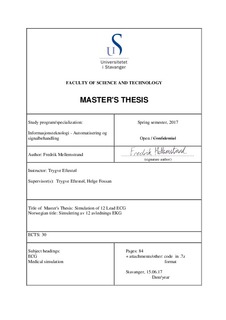| dc.contributor.advisor | Eftestøl, Trygve | |
| dc.contributor.advisor | Fossan, Helge | |
| dc.contributor.author | Mellemstrand, Fredrik | |
| dc.coverage.spatial | Norway | nb_NO |
| dc.date.accessioned | 2017-09-19T13:32:56Z | |
| dc.date.available | 2017-09-19T13:32:56Z | |
| dc.date.issued | 2017-06 | |
| dc.identifier.uri | http://hdl.handle.net/11250/2455552 | |
| dc.description | Master's thesis in Cybernetics and signal processing | nb_NO |
| dc.description.abstract | Simulation is commonly used in the training of medical professionals; including nurses,
emergency responders and doctors. By using real equipment with medical simulators it
allows for a much more realistic experience, allowing the students to get experience with
the actual equipment to be used later with real patients.
The idea behind this project is to develop methods to allow the simulation of 12 Lead
ECG based on real recordings, such that users can connect devices such as patient
monitors, defibrillators and electrocardiographs to a simulator and record realistic ECG.
In the report it is presented how a 12 Lead ECG with synchronized leads can be calculated
into the voltage potentials, which in turn can be generated to the ECG electrodes.
It is then showed how the QRS complexes and waves of the ECG is detected. This is
used to segment the ECG recording into beats, and a representative beat is found as the
median beat of all the segmented beats fulfilling different criteria. The representative
beat of the ECG is then modeled by a simple parametric model and it is showed how
this can be used for realistic simulation of normal sinus rhythms at different heart rates,
as well as presenting signs of conditions like myocardial infarction.
In the project the simulations were based on the PTB Diagnostic ECG database, a
database consisting of 549 ECG recordings from 290 different healthy volunteers or subjects
with different heart diseases. In the report it is showed how the voltage potentials
required for simulation could be calculated from the records in the database. The ECG
was then reconstructed from the voltage potentials with low errors on most records in
the database. The parametric model was fit to all the records of the database, and for
many records the model seems to represent the ECG quite well. Finally it is showed
how rate adjustment and myocardial infarction simulation would look on some of the
records in the database. | nb_NO |
| dc.language.iso | eng | nb_NO |
| dc.publisher | University of Stavanger, Norway | nb_NO |
| dc.relation.ispartofseries | Masteroppgave/UIS-TN-IDE/2017; | |
| dc.rights | Navngivelse 4.0 Internasjonal | * |
| dc.rights.uri | http://creativecommons.org/licenses/by/4.0/deed.no | * |
| dc.subject | informasjonsteknologi | nb_NO |
| dc.subject | ECG | nb_NO |
| dc.subject | signalbehandling | nb_NO |
| dc.subject | medical simulation | nb_NO |
| dc.subject | automatisering | nb_NO |
| dc.title | Simulation of 12 Lead ECG | nb_NO |
| dc.type | Master thesis | nb_NO |
| dc.subject.nsi | VDP::Teknologi: 500::Informasjons- og kommunikasjonsteknologi: 550::Teknisk kybernetikk: 553 | nb_NO |

